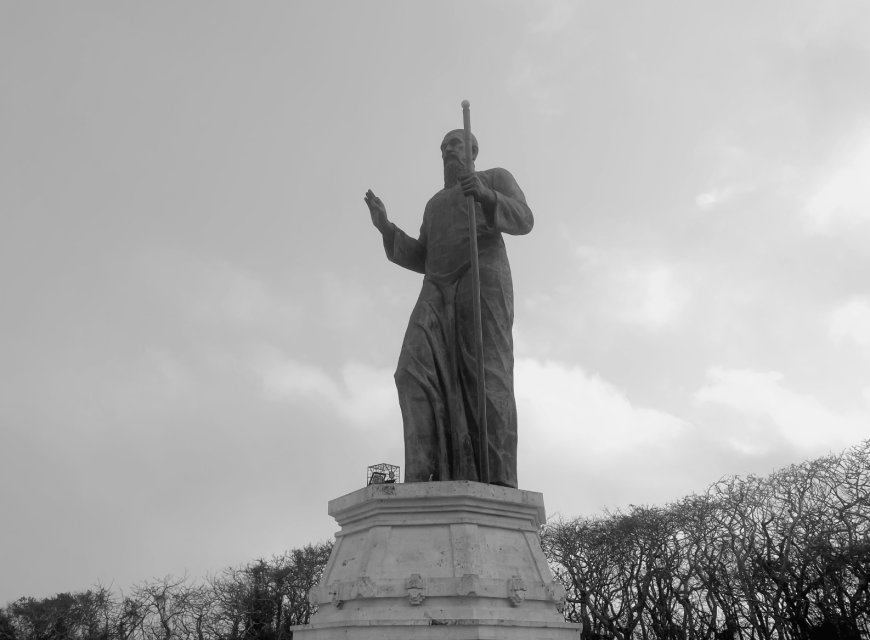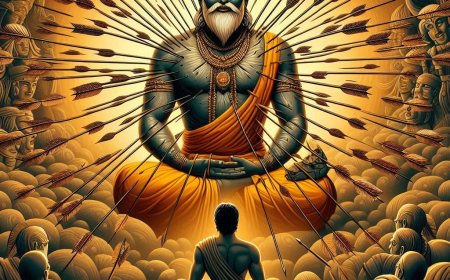Dang Hyang Nirartha: Spiritual Traces of Hindu Brahmin Ancestors in Bali
The descendants of Danghyang Nirartha on the island of Bali have an important role in guarding religious traditions in the region, especially in the Shiva Brahmin sphere. These descendants act as the main bearers and builders in the order of religious life in Bali.

Dang Hyang Nirartha Statue at Uluwatu Temple (Photo Source: Personal Collection)
At the end of the 15th century, the Majapahit Kingdom experienced destruction caused by a number of factors. Apart from internal conflicts such as the Paregreg War to seize power in Majapahit, the collapse was also influenced by attacks from the Demak Kingdom which adhered to Islam. Some belonging to the Aryan caste and clergy chose to go to Bali, where the influence of Hinduism was still strong. They sought refuge in Bali to escape the influence of Islam in Java. One of the famous clergy figures who made this move was Danghyang Nirartha or Danghyang Dwijendra.
In 1489 AD, Danghyang Nirartha came to Bali during the dharmayatra during the reign of King Sri Dalem Waturenggong. However, he never returned to Java, because Hinduism in Java had been suppressed by Islam. He taught Hinduism with a focus on Shiva Sidhanta, prioritizing the Tri Purusa, namely Paramasiwa, Sadasiwa, and Shiva. Danghyang Nirartha really glorified Sadasiwa, and that is why a special shrine called Padmasana was made to worship God Almighty.
Before arriving in Bali, Danghyang Nirartha initially lived in Kediri, East Java, where he had two descendants with Diyah Komala, the daughter of Dang Hyang Panawaran who came from Daha, namely Ida Ayu Swabhawa and Ida Kemenuh. The descendants of Ida Kemenuh later became the Kemenuh Brahmins in Bali.
After Kediri, Danghyang Nirartha moved to Pasuruan, where he had four sons with Diyah Sangawati, the daughter of Dang Hyang PandawASI, namely Ida Kuluan, Ida Wetan, Ida Ler, and Ida Lor. Due to their mother's background from Manuaba, their descendants became known as Manuaba Brahmins.
After Pasuruan, Danghyang Nirartha moved to Blambangan, where he married Patni Keniten who was the sister of Sri Aji Juru, king of Blamangan and had children named Ida Istri Rai, Ida Sakti Telaga, and Ida Kaniten. These descendants were known as Keniten Brahmins. Those are the sons and daughters of Danghyang Nirartha whose mothers are from Java, respectively from Daha, Pasuruhan and Brambangan.

Dang Hyang Nirartha Statue at Griya Bunutan (Photo Source: Personal Collection)
Upon arrival in Bali, Danghyang Nirartha settled in the village of Mas, where he married Diyah Ema, the daughter of Prince Mas, the local leader. From this marriage, he had a son, namely Ida Timbul or known as Ida Alangkajeng, Ida Penarukan, or Ida Sigaran. These descendants became known as Brahmana Mas. During his journey, Danghyang Nirartha still had two sons, namely Ida Patapan, his mother was the daughter of Bendesa Gatling Wani, and Ida Bindu, his mother was Ni Berit. Both of his wives were former servants of Diyah Ema, and had listened to spiritual teachings from Danghyang Nirartha.
So, the sons of Danghyang Nirartha each established their own identity: Brahmin Kemenuh, Brahmin Manuaba, Brahmin Keniten, Brahmin Mas, and Brahmin Patapan.
Furthermore, Danghyang Nirartha's sons in Bali passed down their respective descendants. For the Manuaba Brahmins, Ida Kuluan revealed the Pedanda Penida in Wanasari and the Pedanda Temban in Tembau, the Pedanda Weser, and the Pedanda Batulumpang. Ida Wetan had sons Pedanda Panida and Pedanda Tegal Suci in Manuaba. Pedanda Ler had a son, Pedanda Teges, and a mother from Srijati. Pedanda Lor has a son, Pedanda Mambal, whose mother is from Pasuruan. Pedanda Lor also has a wife who is the daughter of I Gusti Dauh Bale Agung who inherited Pedanda Buruan who had the title Pedanda Manuaba who boarded in Manuaba, Gianyar. Pedanda Sakti Manuaba married a wife from Bajangan, then had a son, Pedanda Gde Taman in Sidawa, Taman Bali, Bangli, who boarded on Buwung hill in Sidawa. Pedanda Sakti Manuaba also married the daughter of Gajah Para from Tianyar, then had sons Pedanda Wayahan Tianyar, Pedanda Nengah Tianyar, and Pedanda Ketut Tianyar.
For the Brahmin Keniten Ida Sakti Telaga, Pedanda Gusti was born. For Brahmin Mas Pedanda Alangkajeng sons Pedanda Sangsi and Pedanda Mas. For the Patapan Brahmins, Ida Patapan had sons Ida Ketut Tabanan and Ida Kukub in Tabanan and Ida Ngenjuk in Lombok. Meanwhile, Ida Kemenuh, the eldest son of Danghyang Nirartha, and his descendants were called Brahmin Kemenuh. Meanwhile, Ida Ayu Swabhawa is enshrined at Pulaki Temple under the name Dewi Melanting. That's how many descendants of Danghyang Nirartha exist on the island of Bali.































































